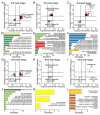Comparative Proteomics Combined with Morphophysiological Analysis Revealed Chilling Response Patterns in Two Contrasting Maize Genotypes
- PMID: 35456000
- PMCID: PMC9024610
- DOI: 10.3390/cells11081321
Comparative Proteomics Combined with Morphophysiological Analysis Revealed Chilling Response Patterns in Two Contrasting Maize Genotypes
Abstract
Maize yield is significantly influenced by low temperature, particularly chilling stress at the maize seedling stage. Various physiological approaches have been established to resist chilling stress; however, the detailed proteins change patterns underlying the maize chilling stress response at the seedling stage remain unknown, preventing the development of breeding-based methods to resist chilling stress in maize. Thus, we performed comprehensive physiological, comparative proteomics and specific phytohormone abscisic acid (ABA) assay on different maize inbred lines (tolerant-line KR701 and sensitive-line hei8834) at different seedling stages (the first leaf stage and third leaf stage) under chilling stress. The results revealed several signalling proteins and pathways in response to chilling stress at the maize seedling stage. Meanwhile, we found ABA pathway was important for chilling resistance of tolerant-line KR701 at the first leaf stage. Related chilling-responsive proteins were further catalogued and analysed, providing a resource for further investigation and maize breeding.
Keywords: chilling stress; differentially expressed protein; maize; proteomics; seedlings.
Conflict of interest statement
The authors declare no competing financial interests.
Figures






References
-
- Presterl T., Ouzunova M., Schmidt W., Möller E.M., Röber F.K., Knaak C., Ernst K., Westhoff P., Geiger H.H. Quantitative trait loci for early plant vigour of maize grown in chilly environments. TAG. Theor. Appl. Genetics. Theor. Und Angew. Genet. 2007;114:1059–1070. doi: 10.1007/s00122-006-0499-4. - DOI - PubMed
Publication types
MeSH terms
Substances
LinkOut - more resources
Full Text Sources
Molecular Biology Databases

